Yamaha CBX-K2 User Manual
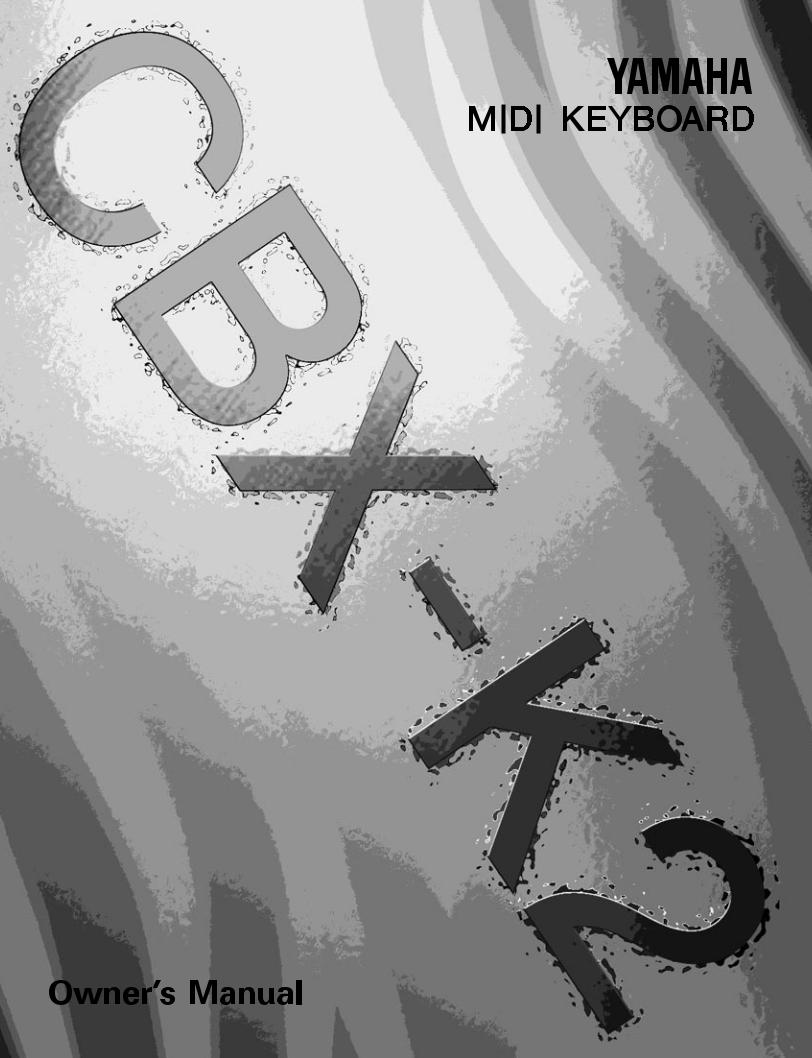

SPECIAL MESSAGE SECTION (U.S.A.)
This product utilizes batteries or an external power supply (adapter). DO NOT connect this product to any power supply or adapter other than one described in the manual, on the name plate, or specifically recommended by Yamaha.
This product should be used only with the components supplied or; a cart, rack, or stand that is recommended by Yamaha. If a cart, etc., is used, please observe all safety markings and instructions that accompany the accessory product.
SPECIFICATIONS SUBJECT TO CHANGE:
The information contained in this manual is believed to be correct at the time of printing. However, Yamaha reserves the right to change or modify any of the specifications without notice or obligation to update existing units.
This product, either alone or in combination with an amplifier and headphones or speaker/s, may be capable of producing sound levels that could cause permanent hearing loss. DO NOT operate for long periods of time at a high volume level or at a level that is uncomfortable. If you experience any hearing loss or ringing in the ears, you should consult an audiologist. IMPORTANT: The louder the sound, the shorter the time period before damage occurs.
NOTICE:
Service charges incurred due to lack of knowledge relating to how a function or effect works (when the unit is operating as designed) are not covered by the manufacturer’s warranty, and are therefore the owners responsibility. Please study this manual carefully and consult your dealer before requesting service.
ENVIRONMENTAL ISSUES:
Yamaha strives to produce products that are both user safe and environmentally friendly. We sincerely believe that our products and the production methods used to produce them, meet these goals. In keeping with both the letter and the spirit of the law, we want you to be aware of the following:
Battery Notice:
This product MAY contain a small non-recharge- able battery which (if applicable) is soldered in place. The average life span of this type of battery is approximately five years. When replacement becomes necessary, contact a qualified service representative to perform the replacement.
This product may also use “household” type batteries. Some of these may be rechargeable. Make sure that the battery being charged is a rechargeable type and that the charger is intended for the battery being charged.
When installing batteries, do not mix old batteries with new, or with batteries of a different type. Batteries MUST be installed correctly. Mismatches or incorrect installation may result in overheating and battery case rupture.
Warning:
Do not attempt to disassemble, or incinerate any battery. Keep all batteries away from children. Dispose of used batteries promptly and as regulated by the laws in your area. Note: Check with any retailer of household type batteries in your area for battery disposal information.
Disposal Notice:
Should this product become damaged beyond repair, or for some reason its useful life is considered to be at an end, please observe all local, state, and federal regulations that relate to the disposal of products that contain lead, batteries, plastics, etc. If your dealer is unable to assist you, please contact Yamaha directly.
NAME PLATE LOCATION:
The name plate is located on the bottom of the product. The model number, serial number, power requirements, etc., are located on this plate. You should record the model number, serial number, and the date of purchase in the spaces provided below and retain this manual as a permanent record of your purchase.
Model |
CBX-K2 |
Serial No.
Purchase Date
92-BP
PLEASE KEEP THIS MANUAL
2
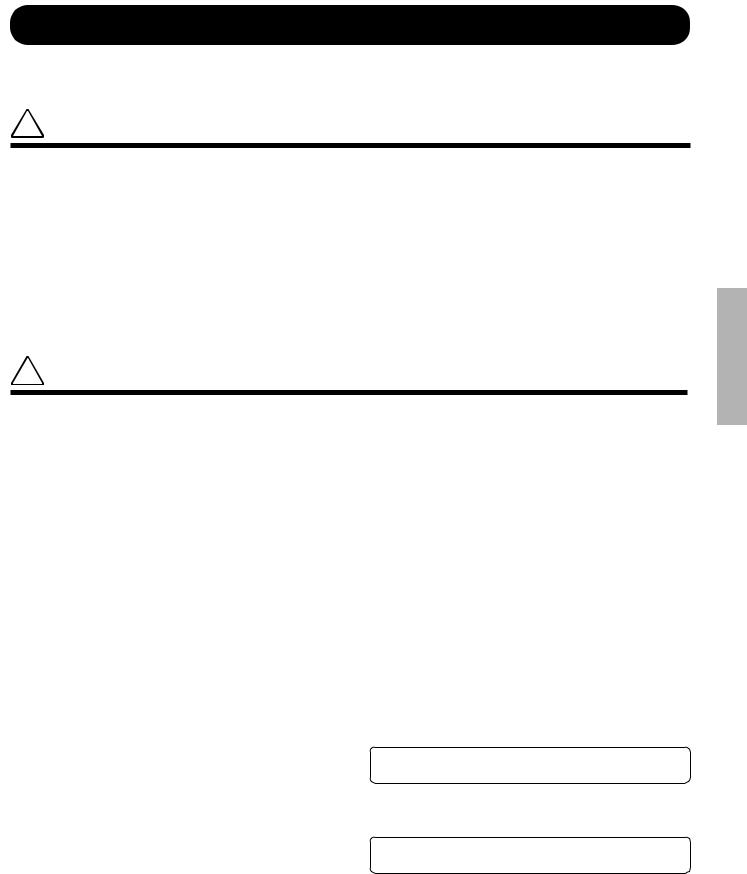
PRECAUTIONS
PLEASE READ CAREFULLY BEFORE PROCEEDING
* Please keep these precautions in a safe place for future reference.
 WARNING
WARNING
Always follow the basic precautions listed below to avoid the possibility of serious injury or even death from electrical shock, short-circuiting, damages, fire or other hazards. These precautions include, but are not limited to, the following:
•Do not open the instrument or attempt to disassemble the internal parts or modify them in any way. The instrument contains no user-serviceable parts. If it should appear to be malfunctioning, discontinue use immediately and have it inspected by qualified Yamaha service personnel.
•Do not expose the instrument to rain, use it near water or in damp or wet conditions, or place containers on it containing liquids which might spill into any openings.
•If the AC adaptor cord or plug becomes frayed or damaged, or if there is a sudden loss of sound during use of the instrument, or if any unusual smells or smoke should appear to be caused by it, immediately turn off
the power switch, disconnect the adaptor plug from the outlet, and have the instrument inspected by qualified Yamaha service personnel.
•Use the specified adaptor (PA-1D or an equivalent recommended by Yamaha) only. Using the wrong adaptor can result in damage to the instrument or overheating.
•Before cleaning the instrument, always remove the electric plug from the outlet. Never insert or remove an electric plug with wet hands.
•Check the electric plug periodically and remove any dirt or dust which may have accumulated on it.
 CAUTION
CAUTION
Always follow the basic precautions listed below to avoid the possibility of physical injury to you or others, or damage to the instrument or other property. These precautions include, but are not limited to, the following:
•Do not place the AC adaptor cord near heat sources such as heaters or radiators, and do not excessively bend or otherwise damage the cord, place heavy objects on it, or place it in a position where anyone could walk on, trip over, or roll anything over it.
•When removing the electric plug from the instrument or an outlet, always hold the plug itself and not the cord.
•Do not connect the instrument to an electrical outlet using a multipleconnector. Doing so can result in lower sound quality, or possibly cause overheating in the outlet.
•Unplug the AC power adaptor when not using the instrument, or during electrical storms.
•Always make sure all batteries are inserted in conformity with the +/- polarity markings. Failure to do so might result in overheating, fire, or battery fluid leakage.
•Always replace all batteries at the same time. Do not use new batteries together with old ones. Also, do not mix battery types, such as alkaline batteries with manganese batteries, or batteries from different makers, or different types of batteries from the same maker, since this can cause overheating, fire, or battery fluid leakage.
•Do not dispose of batteries in fire.
•Do not attempt to recharge batteries that are not intended to be charged.
•If the instrument is not to be in use for a long time, remove the batteries from it, in order to prevent possible fluid leakage from the battery.
•Keep batteries away from children.
•Before connecting the instrument to other electronic components, turn off the power for all components. Before turning the power on or off for all components, set all volume levels to minimum.
•Do not expose the instrument to excessive dust or vibrations, or extreme cold or heat (such as in direct sunlight, near a heater, or in a car during the day) to prevent the possibility of panel disfiguration or damage to the internal components.
•Do not use the instrument near other electrical products such as televisions, radios, or speakers, since this might cause interference which can affect proper operation of the other products.
•Do not place the instrument in an unstable position where it might accidentally fall over.
•Before moving the instrument, remove all connected adaptor and other cables.
•When cleaning the instrument, use a soft, dry cloth. Do not use paint thinners, solvents, cleaning fluids, or chemical-impregnated wiping cloths. Also, do not place vinyl, plastic or rubber objects on the instrument, since this might discolor the panel or keyboard.
•Do not rest your weight on, or place heavy objects on the instrument, and do not use excessive force on the buttons, switches or connectors.
•Do not operate the instrument for a long period of time at a high or uncomfortable volume level, since this can cause permanent hearing loss. If you experience any hearing loss or ringing in the ears, consult a physician.
Yamaha cannot be held responsible for damage caused by improper use or modifications to the instrument, or data that is lost or destroyed.
Always turn the power off when the instrument is not in use.
Make sure to discard used batteries according to local regulations.
*The LED display and diagrams in this owner’s manual are for instructional purposes only, and may be different from the ones on your instrument.
(4)-2 |
3 |
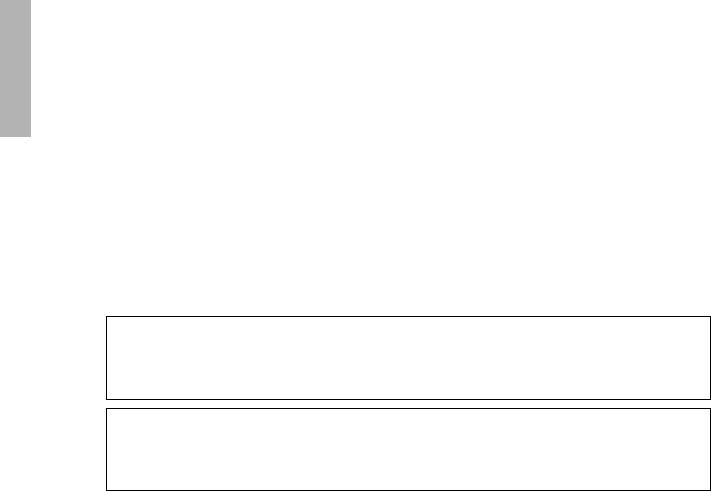
Welcome to the CBX-K2
Congratulations and thank you for purchasing the Yamaha CBX-K2 MIDI Keyboard!
The CBX-K2 is a sophisticated, yet compact MIDI keyboard controller, for use with computers and MIDI music systems. It allows you to play connected tone generators and rhythm machines, and enter performance data to sequencers and computers. It features a sophisticated touch-sensitive keyboard that can be adjusted to cover the full 128-note MIDI range. It also provides a wealth of MIDI controls that allow you to send virtually any MIDI message directly from the keyboard. Moreover, the CBX-K2 has three built-in assignable controllers: Assignable Wheel, Assignable Slider and Assignable Footswitch. The Assignable Wheel and Assignable Slider can be set to control virtually any parameter on your connected tone generator or sequencer in real time, while the Assignable Footswitch can be used for sustain, certain sequencer controls, or as an alternate SHIFT button. Because of its portable size, convenient battery/AC adaptor power supply, compatibility with General MIDI (GM) and XG, and extraordinarily powerful and comprehensive MIDI control functions, the CBX-K2 is an invaluable tool — a MIDI Swiss army knife, of sorts — for all MIDI musicians and performers.
IMPORTANT ■ The CBX-K2 does not contain an internal tone generator. In order to play sounds from the CBX-K2, you need an external tone generator, such as the Yamaha MU series or TG series tone generators.
NOTE ■ The many MIDI functions and features of the CBX-K2 may not be supported by your particular MIDI device. Be sure to refer to the owner’s manual of your particular MIDI device when using it with the CBX-K2.
4
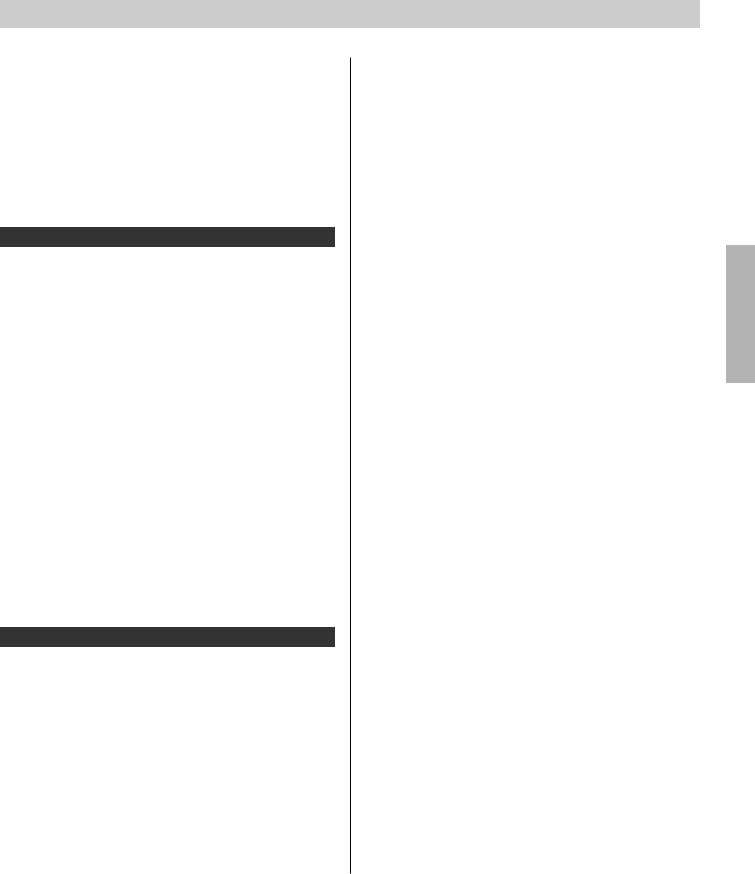
Contents
The CBX-K2 — What It Is and What It Can Do ............... |
6 |
What It Is ................................................................. |
6 |
What It Can Do ........................................................ |
6 |
How to Use This Manual ................................................. |
7 |
Panel Controls and Terminals......................................... |
8 |
■ Note Range of the CBX-K2 (with Octave Shift ) .... |
9 |
■ Default Settings of the CBX-K2 ........................... |
10 |
Guided Tour |
|
Power Supply .................................................................. |
12 |
■ Using a Power Adaptor ....................................... |
12 |
■ Using Batteries .................................................. |
12 |
■ When to Replace the Batteries ............................ |
12 |
Setting Up Your CBX-K2 ................................................. |
13 |
What You’ll Need ..................................................... |
13 |
Setup Examples ...................................................... |
13 |
■ With Computer and Tone Generator .................... |
13 |
■ With Sequencer ................................................. |
14 |
■ With Tone Generator ........................................... |
14 |
■ With Main Keyboard and Tone Generator ............ |
15 |
Making the Connections .......................................... |
15 |
Playing and Using Your CBX-K2 .................................... |
16 |
Selecting and Playing Voices .................................... |
16 |
Changing the Voice Banks ....................................... |
17 |
Changing the Octave Range .................................... |
17 |
Using the Pitch Bend Wheel, Assignable Wheel, and |
|
Assignable Slider .................................................... |
18 |
Re-assigning the Assignable Wheel and Slider ......... |
18 |
Changing the Touch Sensitivity of the Keyboard ........ |
19 |
Reference |
|
Using the SHIFT-Related Functions .............................. |
20 |
Basic Operations ..................................................... |
21 |
■ Selecting Group A and Group B Functions .......... |
21 |
■ Entering Values .................................................. |
21 |
■ Value Entry — Some Specific Examples |
|
and Anomalies .................................................. |
21 |
Setting the Functions...................................................... |
22 |
Group A Operations ................................................. |
22 |
Group B Operations ................................................. |
24 |
Group A Functions — List .............................................. |
26 |
Group B Functions — List .............................................. |
28 |
Assignable Wheel & Slider |
|
— Controller Number List .............................................. |
30 |
About MIDI ...................................................................... |
31 |
MIDI Messages Transmitted by the CBX-K2 .............. |
31 |
CHANNEL MESSAGES ........................................... |
31 |
SYSTEM MESSAGES ............................................. |
33 |
MIDI Data Format ........................................................... |
34 |
MIDI Reception ....................................................... |
34 |
MIDI Transmission ................................................... |
34 |
MIDI Implementation Chart ...................................... |
36 |
Troubleshooting .............................................................. |
37 |
Error Messages ............................................................... |
38 |
Specifications ................................................................. |
39 |
About RPN and NRPN ....................................................... |
39 |
Index ................................................................................ |
40 |
5

The CBX-K2 — What It Is and What It Can Do
What It Is
The CBX-K2 is a compact, highly portable 49-key MIDI keyboard, designed especially for use with computers and MIDI music systems. The CBX-K2 does not generate any sound itself, but can be used as a keyboard controller for playing sounds on a connected tone generator or rhythm machine. It’s also ideal for recording to sequencers and computers. The keyboard is touch-sensitive and its octave range can be changed to cover the full 128-note MIDI range.
The true power and flexibility of the CBX-K2 is in its comprehensive MIDI controls. The CBX-K2 allows you to send virtually any type of MIDI message to connected MIDI devices. Pre-programmed commands provide easy control of basic sequencer/rhythm machine functions such as Start, Stop, Tempo and Song Select, while comprehensive program change commands let you easily select program banks and voices.
Most importantly, though, the CBX-K2 has an Assignable Wheel and Slider that can be set for control of any controller number. This means that you can use the Assignable Wheel to control a wide variety of parameters on your connected tone generator — such as Volume, Pan, Brightness, and the Depth of various effects — in real time. This gives you expressive control over different aspects of the sound in live performance.
The CBX-K2 is also the latest instrument in the Yamaha line to support the XG format, a new addition to the General MIDI standard. In short, XG provides for more instrument sounds and variations, and greater expressive control over voices and effects. With the use of the Assignable Wheel or Slider on the CBX-K2, you have direct realtime control over many of these newly supported functions and parameters.
What It Can Do
Here are a few application ideas on how you can use the CBX-K2. The list below is not comprehensive, but is meant to be a general guide to the possibilities and provide a starting point or springboard for your own creative ideas and explorations.
● Using With a MIDI Tone Generator
In one of the most basic setups, you can play a connected tone generator from the CBX-K2. Because it’s so compact and portable, you can even use it as a hand-held keyboard for live performance.
● Using as a Second Keyboard or Dedicated
MIDI Controller
The CBX-K2 is small enough to fit on top of nearly any keyboard, making it perfect as a second keyboard. Since the CBX-K2 has a MIDI IN terminal, you can connect it between your main keyboard and your tone generator, and use the extensive MIDI capabilities of the CBX-K2 for greater expressive control during your performance.
● Using in a MIDI Music System
Combined with a laptop computer and a compact tone generator (like the General MIDI/XG-compatible Yamaha MU100R), the CBX-K2 gives you comprehensive music making power — for recording, composing, arranging, practicing, and editing — in a portable system that’s ready to go wherever you go. The CBX-K2 is an ideal addition to larger MIDI studios as well, since it provides far greater
MIDI control and flexibility than nearly any other keyboard controller. Use it along side your main MIDI keyboard as a kind of MIDI Swiss army knife — sending necessary MIDI messages, working the real-time controllers, or editing already recorded sequencer tracks.
● Multimedia
Since it’s portable and compatible with the General MIDI and XG formats, the CBX-K2 is a natural for multimedia applications. Because of its ease of use and comprehensive functions, it’s the only keyboard you’ll ever need for recording and editing MIDI data on your multimedia creations.
6
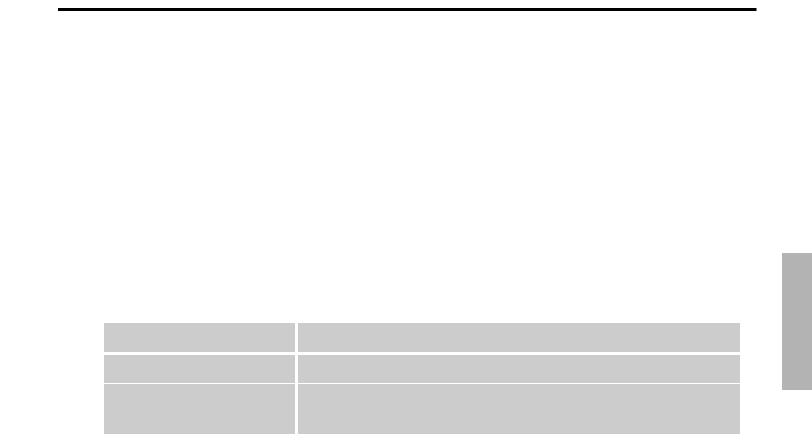
How to Use This Manual
By and large, the CBX-K2 is very easy to use and this manual is self-explanatory. However, we strongly recommend that you take time to read the manual — especially before trying some of the more sophisticated MIDI functions. Read through all of the initial sections first, then go on to the “ Guided Tour” to set up your CBX-K2, learn how to use its various functions, and try out some of the practical application examples to help you become more familiar with its operations. For those who need to delve deeper, the “ Reference” section provides at-a-glance information and important details on all functions.
The following conventions are used throughout this manual:
*Panel buttons and controls are indicated as they appear on the actual instrument. (For example, Cand
M.
*The functions and features assigned to the keyboard are shown like this: Tand {.
*Unless indicated otherwise, Lrefers to either of the ENTER keys, Jor K. However, when you wish to enter a decimal value, make sure to press K. Likewise, when entering a hexadecimal number, make sure to press J.
*Actual MIDI data messages (in hexadecimal) are indicated as follows: <<FE>> and <<En 00 40>>, etc.
*Operation steps are indicated as follows:
Example |
Actual Operation |
C+ E |
While holding down the Cbutton, press E(D1). |
C+ U→ L While holding down the Cbutton, first press U(Fm1), then press L(either Jor K).
7
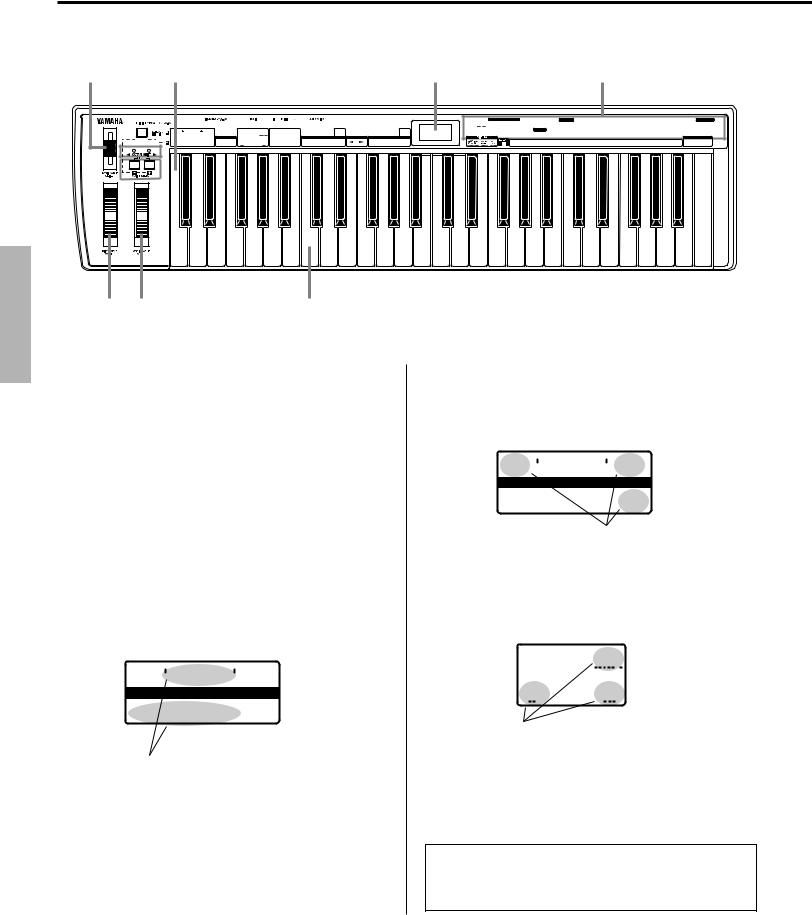
Panel Controls and Terminals
■ Front Panel
r t u y |
i |
o |
|
|
|
|
|
|
|
|
|
TIMESIGNATURE |
|
VOICE |
POLY/ |
|
|
|
|
|
|
|
|
|
|
|
|
|
|
|
|
|
|
|
|
|
|
|
|
|
|
|
|
|
|
|
SONG |
|
|
RESET SOUND OFF TG300B |
CHANNEL DEVICE |
TOUCH |
|
|
|
|
DATA |
MSB 1ST/ |
FOOT SW |
|
|
PB |
DATA |
|||||||||||||||
|
|
|
|
B |
SELECT |
TOP |
BOTTOM |
MEASURE |
MAP |
MONO |
|
CONTROL |
ALL CH |
RESET |
MERGE |
NUMBER SENSITIVITY |
RPN |
CONTROLLER |
NRPN |
DENSITY |
LSB 1ST |
ASSIGN |
|
|
DENSITY |
DENSITY |
|||||||||||
|
|
|
|
|
|
|
|
|
SEQUENCER |
|
PROGRAM |
|
|
RESET |
|
|
|
SYSTEM |
|
WHEEL ASSIGN |
|
TRANSPOSE |
|
SLIDER ASSIGN |
|
||||||||||||
|
|
|
|
|
|
STOP |
CONTINUE |
START |
TEMPO |
BANK PROGRAM |
|
GM |
SOUND |
XG |
MERGE |
|
|
MIDI |
FIXED |
RPN |
CONTROLLER |
NRPN |
DRUM |
|
|
|
RPN CONTROLLER NRPN |
DRUM |
|||||||||
|
|
|
|
|
|
SELECT |
CHANGE |
|
ON |
OFF |
ON |
ON/OFF |
|
|
CH |
VELOCITY |
NUMBER |
|
|
|
NUMBER |
||||||||||||||||
|
|
|
|
|
|
|
|
|
|
|
|
|
|
|
|
|
|
|
|
|
|
|
|
|
|
|
|
|
|
|
|
|
|
|
|
|
|
|
|
|
|
|
|
|
|
|
|
|
|
|
|
|
|
|
|
|
|
|
|
|
|
|
|
|
|
|
|
|
|
|
|
|
|
|
|
CONTROLLER |
|
CONTROL CHANGE |
|
|
|
|
|
|
|
|
NRPN |
|
|
|
|
|
|
|
|
|
|
|
|
|
|
|
|
|
|
|
|
OTHERS |
|||||||
NUMBER LIST |
1 |
MODULATION |
11 |
EXPRESSION |
91 |
REVERB |
|
123 |
|
VIBRATO RATE |
131 |
EQ LO FREQUENCY |
|
139 |
DRUM EG DECAY RATE |
147 |
DRUM HP FILTER CUTOFF |
152 |
CH PRESSURE |
||||||||||||||||||||
|
|
2 |
BREATH |
64 |
HOLD1(DAMPER) |
93 |
CHORUS |
|
124 |
|
VIBRATO DEPTH |
132 |
EQ HI FREQUENCY |
|
140 |
DRUM PITCH COARSE |
148 |
DRUM EQ LO GAIN |
|
|
153 |
KEY PRESSURE |
|||||||||||||||||
|
|
5 |
PORTA TIME |
65 |
PORTAMENTO |
94 |
VARIATION |
|
125 |
|
VIBRATO DELAY |
133 |
EG ATTACK TIME |
|
141 |
DRUM PITCH FINE |
|
149 |
DRUM EQ HI GAIN |
|
|
154 |
MASTER VOLUME |
||||||||||||||||
|
|
6 |
DATA ENTRY |
71 |
HARMONIC |
|
RPN |
|
126 |
|
LP FILTER CUTOFF |
134 |
EG DECAY TIME |
|
|
142 |
DRUM LEVEL |
|
150 |
DRUM EQ LO FREQUENCY |
156 |
MASTER TUNING |
|||||||||||||||||
|
|
7 |
VOLUME |
72 |
RELEASE TIME |
|
|
127 |
|
LP FILTER RESONANCE |
135 |
EG RELEASE TIME |
|
143 |
DRUM PAN |
|
151 |
DRUM EQ HI FREQUENCY |
157 |
VELOCITY |
|||||||||||||||||||
|
|
10 |
PANPOT |
73 |
ATTACK TIME |
120 |
PB SENSITIVITY |
|
128 |
|
HP FILTER CUTOFF |
136 |
DRUM LP FILTER CUTOFF |
|
144 |
DRUM REVERB |
|
|
|
|
|
|
|
158 |
TEMPO |
||||||||||||||
|
|
|
|
|
74 |
BRIGHTNESS |
121 |
FINE TUNE |
|
129 |
|
EQ LO GAIN |
|
|
137 |
DRUM LP FILTER RESONANCE |
145 |
DRUM CHORUS |
|
|
|
|
|
|
|
|
|
|
|||||||||||
|
|
|
|
|
84 |
PORTA CTRL |
122 |
COARSE TUNE |
|
130 |
|
EQ HI GAIN |
|
|
138 |
DRUM EG ATTACK RATE |
|
146 |
DRUM VARIATION |
|
|
|
|
|
|
ENTER |
|||||||||||||
|
|
|
|
B |
|
|
|
|
|
|
|
|
|
|
|
|
|
|
|
|
|
|
|
|
|
|
|
|
|
|
|
|
|
|
HEXA |
|
|
|
|
|
|
|
|
|
1 |
2 |
|
3 |
4 |
|
5 |
|
6 |
|
7 |
|
8 |
9 |
|
A |
B |
|
C |
D |
E |
|
|
F |
0 |
DECIMAL |
DECIMAL |
||||||||
|
|
|
|
|
|
|
|
|
|
|
|
|
|
|
|
|
|
|
|
|
|
|
|
|
|
|
|
|
|
|
|
|
|
|
|
|
|
|
|
w e |
q |
qKeyboard
The CBX-K2 has a 49-key, 4-octave keyboard (C1 to C5), featuring initial touch (velocity) control. All note on, note off and velocity data is transmitted via the MIDI OUT terminal. When used with the Cbutton, the keys are used for changing various settings and sending special MIDI messages. (Page 20.)
About the Functions of the CBX-K2: The functions are divided into two groups: Group A and Group B. The Group A and B functions are shown on the panel, above the left section of the keyboard. Several functions can be used by pressing only the relevant key; in other words, pressing Lis not necessary. These functions, such as Sequencer Stop and Start, are shown on the panel without underline.
SONG |
|
TIMESIGNATURE |
|
|
|
|
|
||||
SELECT |
TOP |
BOTTOM MEASURE |
|||
SEQUENCER
STOP CONTINUE START TEMPO
These non-underlined functions can be used without pressing L.
The right section of the keyboard serves as value entry and is used for those functions whose names are underlined on the panel and require value entry, such as Program Change and Tempo.
SONG |
|
TIMESIGNATURE |
|
|
|
|
|
||||
SELECT |
TOP |
BOTTOM MEASURE |
|||
SEQUENCER
STOP CONTINUE START TEMPO
These underlined functions require value entry and pressing L.
Functions whose names appear with a dashed underline on the panel (for example, GM ON and XG ON) require pressing L.
RESET SOUND OFF TG300B
CONTROL |
ALL CH |
RESET |
|
RESET |
|
GM |
SOUND |
XG |
ON |
OFF |
ON |
These functions with dashed underline need no value entry, but require pressing
L.
Value entry on the CBX-K2 can be done in two number systems: Decimal and Hexadecimal. The keys labeled A through F are for Hexadecimal entry.
NOTE ■ The normal (default) velocity range of the CBX-K2 is from 1 to 127. The range differs according to the Touch Sensitivity setting (pages 19, 28).
8
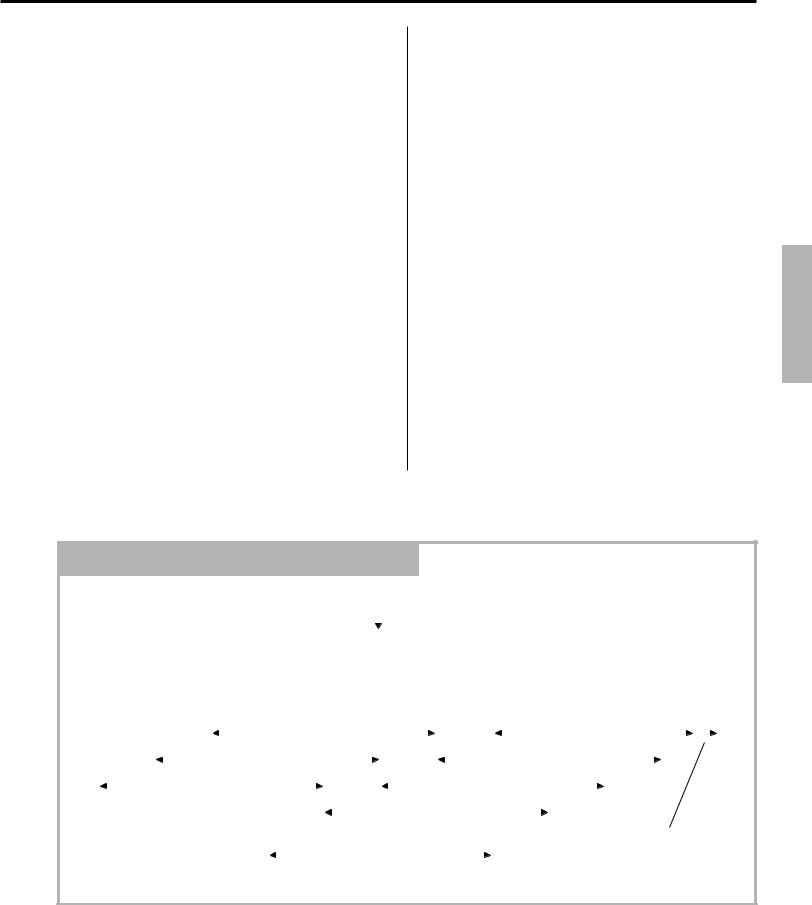
Panel Controls and Terminals
wPitch Bend Wheel (Pitch Bend)
This spring-loaded Wheel controls Pitch Bend. (Page 18.)
eAssignable Wheel
When the CBX-K2 is turned on, this Wheel (with center detent) is set to control Modulation Depth of the connected MIDI device. It can be set to control other functions; see on pages 18 and 26 for details. Turning the Wheel will momentarily show the currently assigned controller number in the LED display.
rAssignable Slider
When the CBX-K2 is turned on, this Slider is set to control the data entry of the connected MIDI device. It can be set to control other functions; see on pages 18 and 26 for details. Moving the Slider will momentarily show the currently assigned controller number in the LED display.
tCButton
This button is used to access the “hidden” functions of the CBX-K2. Used with the N/ Mbuttons (when the LED display is set to Program Change, Bank MSB, or Bank LSB), it allows you to step up or down through program numbers. (Page 16.)
Note Range of the CBX-K2 (with Octave Shift)
Whenever turned on, the program number is set to 001. Used with the keys of the keyboard, it allows you to access the sophisticated MIDI control functions. (Page 20.)
yN/ MButtons
These buttons are used to change the octave range of the keyboard, allowing you to play across the entire range of MIDI notes (C-2 to G8). When the octave setting is modified, the current octave setting is momentarily displayed on the LED. (Page 17.) Press both of these buttons together to restore the normal octave setting (C1 to C5).
uN/ MLamps
These lamps provide several indications:
•During normal playing conditions, these (along with the LED display) indicate the octave setting of the keyboard, up (M) or down (N). Both light together for the normal octave setting. When changing the octave setting, these flash to indicate the number of octaves, up or down. (Page 17.)
•When using some of the “hidden” functions, these flash when a MIDI message is transmitted or when a function is executed.
Middle C
(C3 or MIDI note number 60)
|
|
|
|
|
|
|
|
|
|
|
|
|
|
|
|
|
|
|
|
|
|
|
|
|
|
|
|
|
|
|
|
|
|
|
|
|
|
|
|
|
|
|
|
|
|
|
|
|
|
|
|
|
|
|
|
|
|
|
|
|
|
|
|
|
|
|
|
|
|
|
|
|
|
|
|
|
|
|
|
|
|
|
|
|
|
|
|
|
|
|
|
|
|
|
|
|
|
|
|
|
|
|
|
|
|
|
|
|
|
|
|
|
|
|
|
|
|
|
|
|
|
|
|
|
|
|
|
|
|
|
|
|
|
|
|
|
|
|
|
|
|
|
|
|
|
|
|
|
|
|
|
|
|
|
|
|
|
|
|
|
|
|
|
|
|
|
|
|
|
|
|
|
|
|
|
|
|
|
|
|
|
|
|
|
|
|
|
|
|
|
|
|
|
|
|
|
|
|
|
|
|
|
|
|
|
|
|
|
|
|
|
|
|
|
|
|
|
|
|
|
|
|
|
|
|
|
|
|
|
|
|
|
|
|
|
|
|
|
|
|
|
|
|
|
|
|
|
|
C-2 |
|
|
|
|
C-1 |
C0 |
|
|
|
|
C1 |
|
|
C2 |
|
|
|
|
C3 |
|
|
|
|
C4 |
|
|
|
|
C5 |
|
|
|
|
C6 |
|
|
|
|
C7 |
|
|
|
|
|
C8 |
|
G8 |
|
|
|||||||||||||||||||||||||||||||||
(0) |
|
(12) |
|
|
|
|
(24) |
(36) |
(48) |
(60) |
(72) |
(84) |
(96) |
(108) |
(120) |
(127) |
|
|
|
|||||||||||||||||||||||||||||||||||||||||||||||||||||||||||||||
|
|
|
|
|
|
|
|
|
|
|
|
|
|
|
|
|
|
|
|
|
|
|
|
|
|
|
|
|
|
|
|
|
|
|
|
|
|
|
|
|
|
|
|
|
|
|
|
|
|
|
|
|
|
|
|
|
|
|
|
|
|
|
|
|
|
|
|
|
|
|
|
|
|
|
|
|
|
|
|
|
|
|
|
|
|
|
|
|
|
|
|
|
|
|
|
|
|
|
|
|
|
|
|
|
|
|
|
|
|
|
|
|
|
|
|
|
|
|
|
|
|
|
|
|
|
|
|
|
|
|
|
|
|
|
|
|
|
|
|
|
|
|
|
|
|
|
|
|
|
|
|
|
|
|
|
|
|
|
|
|
|
|
|
|
|
|
|
|
|
|
|
|
|
|
|
|
|
|
|
|
|
|
|
|
|
|
|
|
|
|
|
1 octave down |
|
|
|
|
|
|
|
|
|
|
|
|
|
|
|
|
|
|
|
|
|
|
|
|
|
|
|
|
4 octaves up |
|
|
|
|
|
|
|||||||||||||||||||||
|
|
|
|
|
|
|
|
|
|
|
|
|
|
|
|
|
|
|
|
|
|
|
|
|
|
|
|
|
|
|
|
|
|
|
|
|
|
|
|
|
|
|
|
|
|
|
|
|
|
|
|
|
|
|
|
|
|
|
|
|||||||||||||||||||||||
|
|
|
|
|
|
|
|
|
|
|
|
|
|
|
|
|
|
|
|
|
|
|
|
|
|
|
|
|
|
|
|
|
|
|
|
|
|
|
|
|
|
|
|
|
|
|
|
|
|
|
|
|
|
|
|
|
|
|
|
|
|
|
|
|
|
|
|
|
|
|
|
|
|
|
|
|
|
|
|
|
|
|
|
|
|
|
|
|
|
|
|
|
|
|
|
|
|
|
|
|
|
|
|
|
|
|
|
|
|
|
|
|
|
|
|
|
|
|
|
|
|
|
|
|
|
|
|
|
|
|
|
|
|
|
|
|
|
|
|
|
|
|
|
|
|
|
|
|
|
|
|
|
|
|
|
|
|
|
|
|
|
|
|
|
|
|
|
|
|
|
|
|
|
|
|
|
|
|
|
|
|
|
|
|
|
|
2 octaves down |
|
|
|
|
|
|
|
|
|
|
|
|
|
|
|
|
|
|
|
|
|
|
|
|
|
|
|
|
|
|
3 octaves up |
|
|
|
|
|
|
|
|
|
|
|
|
|
|
||||||||||||||||
|
|
|
|
|
|
|
|
|
|
|
|
|
|
|
|
|
|
|
|
|
|
|
|
|
|
|
|
|
|
|
|
|
|
|
|
|
|
|
|
|
|
|
|
|
|
|
|
|
|
|
|
|
|
|
|
|
|
|
|
|
|
|
|
|
||||||||||||||||||
|
|
|
|
|
|
|
|
|
|
|
|
|
|
|
|
|
|
|
|
|
|
|
|
|
|
|
|
|
|
|
|
|
|
|
|
|
|
|
|
|
|
|
|
|
|
|
|
|
|
|
|
|
|
|
|
|
|
|
|
|
|
|
|
|
|
|
|
|
|
|
|
|
|
|
|
|
|
|
|
|
|
|
|
|
|
|
|
|
|
|
|
|
|
|
|
|
3 octaves down |
|
|
|
|
|
|
|
|
|
|
|
|
|
|
|
|
|
|
|
|
|
|
|
|
|
|
|
|
2 octaves up |
|
|
|
|
|
|
|
|
|
|
|
|
|
|
|
|
|
|
|
|
|
|
|||||||||||||||||
|
|
|
|
|
|
|
|
|
|
|
|
|
|
|
|
|
|
|
|
|
|
|
|
|
|
|
|
|
|
|
|
|
|
|
|
|
|
|
|
|
|
|
|
|
|
|
|
|
|
|
|
|
|
|
|
|
|
|
|
|
||||||||||||||||||||||
|
|
|
|
|
|
|
|
|
|
|
|
|
|
|
|
|
|
|
|
|
|
|
|
|
|
|
|
|
|
|
|
|
|
|
|
|
|
|
|
|
|
|
|
|
|
|
|
|
|
|
|
|
|
|
|
|
|
|
|
|
|
|
|
|
|
|
|
|
|
|
|
|
|
|
|
|
|
|
|
|
|
|
|
|
|
|
|
|
|
|
|
|
|
|
|
|
|
|
|
|
|
|
|
|
|
|
|
|
|
|
|
|
|
|
|
|
|
|
|
|
|
|
|
|
|
|
|
|
|
|
|
|
|
|
|
|
|
|
|
|
|
|
|
|
|
|
|
|
|
|
|
|
|
|
|
|
|
|
|
|
|
|
|
|
|
|
|
|
|
|
|
|
|
|
|
|
|
|
|
|
|
|
|
|
|
|
|
|
|
|
|
|
|
|
|
|
|
|
|
|
|
|
|
|
|
|
|
|
|
1 octave up |
|
|
|
|
|
|
|
|
|
|
|
|
|
|
|
|
This section is outside |
|||||||||||||||||||||
|
|
|
|
|
|
|
|
|
|
|
|
|
|
|
|
|
|
|
|
|
|
|
|
|
|
|
|
|
|
|
|
|
|
|
|
|
|
|
|
|
|
|
|
|
|
|
|
|
|
|
|
|
|
|
|
|
|
|
|
|||||||||||||||||||||||
|
|
|
|
|
|
|
|
|
|
|
|
|
|
|
|
|
|
|
|
|
|
|
|
|
|
|
|
|
|
|
|
|
|
|
|
|
|
|
|
|
|
|
|
|
|
|
|
|
|
|
|
|
|
|
|
|
|
|
|
|
|
|
|
|
|
|
|
|
||||||||||||||
|
|
|
|
|
|
|
|
|
|
|
|
|
|
|
|
|
|
|
|
|
|
|
|
|
|
|
|
|
|
|
|
|
|
|
|
|
|
|
|
|
|
|
|
|
|
|
|
|
|
|
|
|
|
|
|
|
|
|
|
|
|
|
|
|
|
|
|
|
||||||||||||||
|
|
|
|
|
|
|
|
|
|
|
|
|
|
|
|
|
|
|
|
|
|
|
|
|
|
|
|
Normal octave range |
|
|
|
|
|
|
|
|
|
|
|
|
|
|
|
|
|
|
|
|
|
|
|
|
the “legal” MIDI range |
|||||||||||||||||||||||||||||
|
|
|
|
|
|
|
|
|
|
|
|
|
|
|
|
|
|
|
|
|
|
|
|
|
|
(default: when power is turned on) |
|
|
|
|
|
|
|
|
|
|
|
|
|
|
|
|
|
|
|
|
|
|
|
|
and plays notes Gm7 |
|||||||||||||||||||||||||||||||
|
|
|
|
|
|
|
|
|
|
|
|
|
|
|
|
|
|
|
|
|
|
|
|
|
|
|
|
|
|
|
|
|
|
|
|
|
|
|
|
|
|
|
|
|
|
|
|
|
|
|
|
|
|
|
|
|
|
|
|
|
|
|
|
|
|
|
|
|
(116) through C8 (120). |
|||||||||||||
|
|
|
|
|
|
|
|
|
|
|
|
|
|
|
|
|
|
|
|
|
|
|
|
|
|
|
|
|
|
|
|
|
|
|
|
|
|
|
|
|
|
|
|
|
|
|
|
|
|
|
|
|
|
|
|
|
|
|
|
|
|
|
|
|
|
|
|
|
||||||||||||||
9

Panel Controls and Terminals
• The right lamp flashes quickly when a MIDI error happens. The lamp flashes until you press any one of the panel buttons.
iLED Display
In normal playing conditions, this displays the currently selected program number (when Yis selected in ·; see on page 22).
When moving the Assignable Wheel or Slider, this flashes the currently active Controller number. (When assigned to RPN or NRPN, the display does not flash.) For the Wheel, the default is 001 - Modulation; for the Slider, the default is 006 - Data Entry.
When changing the octave setting, this momentarily indicates the number of octaves, up or down, from the normal octave setting. The range is -3 (3 octaves down) to 0 (normal) to 4 (4 octaves up).
The display also indicates the status of the MIDI control operations. Depending on the operation performed, the display may:
•Flash rapidly, indicating the selected MIDI message has been sent. (Ex.: When pressing C+ Q.)
•Show the current condition or value. (Ex.: When pressing C+ R.) It also displays the entered value when changing a function’s setting.
oCONTROLLER NUMBER LIST
This is a list of some of the main controller numbers (and their names) that can be used with the Assignable Wheel and Slider. (For a complete list, see on page 30.)
Default Settings of the CBX-K2
The CBX-K2 has no internal memory backup. As a result, all settings are returned to the factory default when turning the power off. The basic factory default settings are listed below.
•Merge: on
•MIDI transmit channel: 1
•Octave range: C1 – C5
•Transpose: normal (no transposition)
•Fixed velocity: off (keyboard is velocity sensitive)
•Assignable Wheel: Modulation
•Assignable Slider: Data entry MSB
■ User-configurable Defaults:
You can change certain power-on default settings of the CBX-K2. These include:
*Reversing the MSB, LSB order. Hold down Nand turn the power on. (Pages 28, 29.)
10
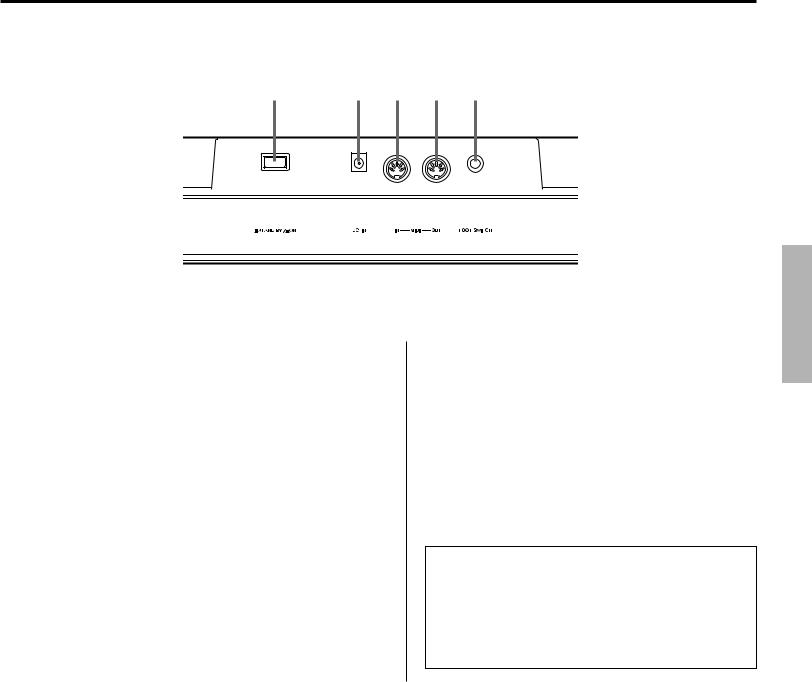
Panel Controls and Terminals
■ Rear Panel
!0 !1 !2 !3 !4
!0POWER Switch
Push this switch in to turn on the power. Each time the power is turned on, the CBX-K2 returns to the default condition. (See boxed section on page 10.)
!1DC IN Terminal
This is for connection to a PA-1D AC adaptor or another adaptor recommended by Yamaha.
!2MIDI IN Terminal
This is for connection to the MIDI OUT terminal of another MIDI device (such as a MIDI keyboard, sequencer or computer that has a MIDI interface), for input of that device’s data. By using the MIDI Merge function, received data can be combined with the data generated by the CBXK2 and transmitted via the MIDI OUT terminal.
!3MIDI OUT Terminal
This is for connection to the MIDI IN terminal of another MIDI device (such as a MIDI tone generator, sequencer or computer that has a MIDI interface), for sending MIDI messages to that device.
!4FOOT SWITCH Jack (1/4” phone)
This is for connection of a pedal switch (such as the optional Yamaha FC4 or FC5). The default control for the Footswitch is sustain on/off (Controller #64). It can be set to control other functions; see on page 28 for details.
NOTE ■ Make sure that the Footswitch plug is properly connected to the FOOT SWITCH terminal before turning on the power.
■ Do not press the Footswitch while turning the power on. Doing this changes the recognized polarity of the Footswitch, resulting in reversed Footswitch operation.
11

Guided Tour
Setting Up the CBX-K2 in Your Music System
Whatever your system, you should follow the basic instructions below when setting up your CBX-K2. Use the example illustrations as a general guide when making the connections with your own system.
Power Supply
Your CBX-K2 will run from the included power adaptor, PA-1D or an equivalent. Batteries can also be used (see below). However, we strongly recommend that you use the power adaptor.
NOTE ■ Before making any connections, make sure that all equipment to be connected is turned off.
Using a Power Adaptor
Connect one end of the power adaptor (PA-1D) to the DC IN jack on the rear panel, and the other end to a suitable electrical outlet.
CAUTION!  ■ Do not attempt to use a power adaptor other than the PA-1D (or another adaptor recommended by Yamaha) . The use of an incompatible adaptor may result in irreparable damage to the CBXK2, and even pose a serious shock hazard.
■ Do not attempt to use a power adaptor other than the PA-1D (or another adaptor recommended by Yamaha) . The use of an incompatible adaptor may result in irreparable damage to the CBXK2, and even pose a serious shock hazard.
■ Be sure to disconnect the power adaptor from the outlet when the CBX-K2 is not in use.
DC IN
STANDBY (?)
Using Batteries
To use the CBX-K2 on battery power, remove the battery compartment cover (as shown below) and insert six 1.5V AA size (SUM-3, R-6 or equivalent) batteries in the battery compartment. Make sure to follow the polarity indications on the bottom case.
Battery compartment cover
Securely replace the battery compartment cover when done installing the batteries.
When to Replace the Batteries
When the battery power runs too low to properly operate the CBX-K2, an “ E1” message appears in the LED display. When this happens, replace all batteries with a complete set of six new batteries of the same type.
CAUTION! ■ NEVER mix old and new batteries or different types of batteries! Also, to prevent possible damage due to battery leakage, remove the batteries from the instrument if it is not to be used for a long time.
■ NEVER mix old and new batteries or different types of batteries! Also, to prevent possible damage due to battery leakage, remove the batteries from the instrument if it is not to be used for a long time.
Power adaptor
12
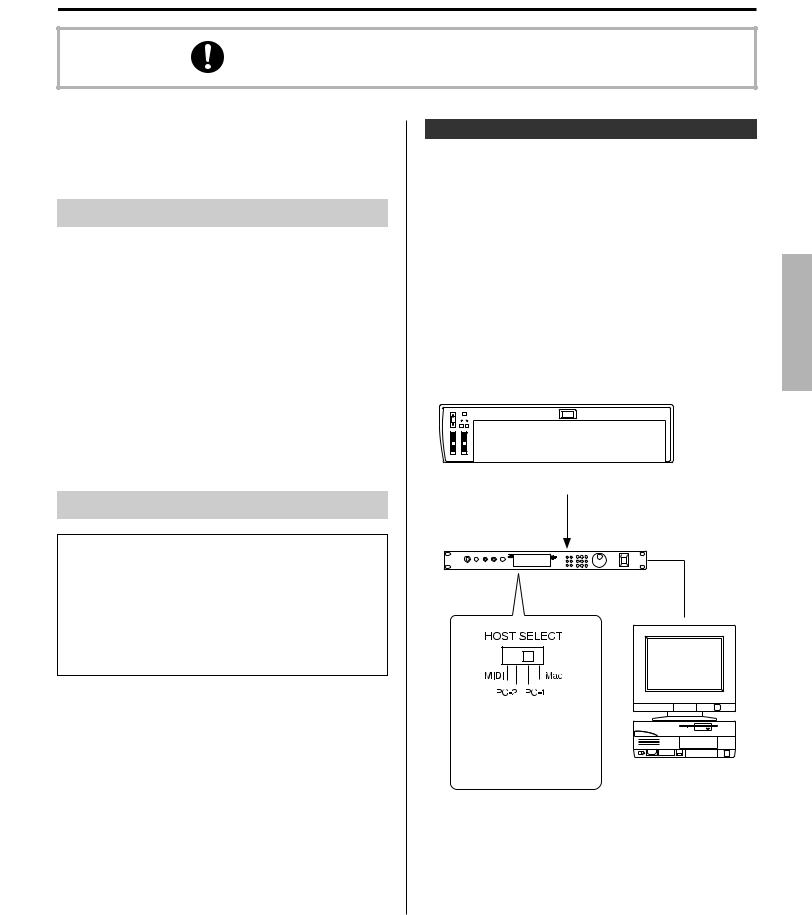
Setting Up Your CBX-K2
All the devices must be turned off before making connections.
In this introductory section, you’ll learn how to set up the CBX-K2 for use in your music system. A variety of setups are covered here; read through the one that most closely matches your own setup.
What You’ll Need
Since the CBX-K2 is strictly a MIDI controller and does not generate any sound by itself, you’ll need other datareceiving and sound-producing equipment. Basically, you will need:
*The CBX-K2 and PA-1D AC power adaptor (or a set of batteries).
*A MIDI device (such as a tone generator, keyboard or computer) which can receive and play back MIDI data, and at least one MIDI cable.
*(Optional) An amplifier/speaker system, preferably stereo, with proper audio connecting cables. Alternately, you can use a set of stereo headphones.
Setup Examples
NOTE ■ All devices must be turned off before making connections.
■ The setup examples below show only the MIDI connections. The audio connections would vary according to the particular equipment you use. Refer to the owner’s manuals of your other equipment for audio connection instructions.
When connecting the instrument to other MIDI devices, be sure to use only high-quality MIDI cables. Also, avoid using cables longer than 15 meters, since long cables can result in data errors.
With Computer and Tone Generator
In the small MIDI system below, the CBX-K2 is connected to a computer and a single tone generator. With the proper sequencing software on the computer, the CBX-K2 can be used both for recording performance data to the computer and playing the sounds of the connected tone generator. You can also conveniently use the CBX-K2 to start and stop the sequencer.
For tone generators with a built-in MIDI interface (such as the Yamaha MU100R)
CBX-K2 |
MIDI OUT |
|||||||||||||||||||||||||||
|
|
|
|
|
|
|
|
|
|
|
|
|
|
|
|
|
|
|
|
|
|
|
|
|
|
|
|
|
|
|
|
|
|
|
|
|
|
|
|
|
|
|
|
|
|
|
|
|
|
|
|
|
|
|
|
|
|
|
|
|
|
|
|
|
|
|
|
|
|
|
|
|
|
|
|
|
|
|
|
|
|
|
|
|
|
|
|
|
|
|
|
|
|
|
|
|
|
|
|
|
|
|
|
|
|
|
|
|
|
|
|
|
|
|
|
|
|
|
|
|
|
|
|
|
|
|
|
|
|
|
|
|
|
|
|
|
|
|
|
|
|
|
|
|
Tone generator |
MIDI IN |
MU100R |
|
TO HOST
 Serial port
Serial port
The HOST SELECT switch |
|
|
on the MU100R allows you |
|
|
to match the type of |
|
|
computer, when connecting |
Computer |
|
directly to a computer. |
||
|
Connect the MIDI OUT terminal on the CBX-K2 to the
MIDI IN terminal on the MU100R. The MU100R should be connected to the proper port on the computer. (For complete connection instructions, refer to the owner’s manual of your particular tone generator.)
13
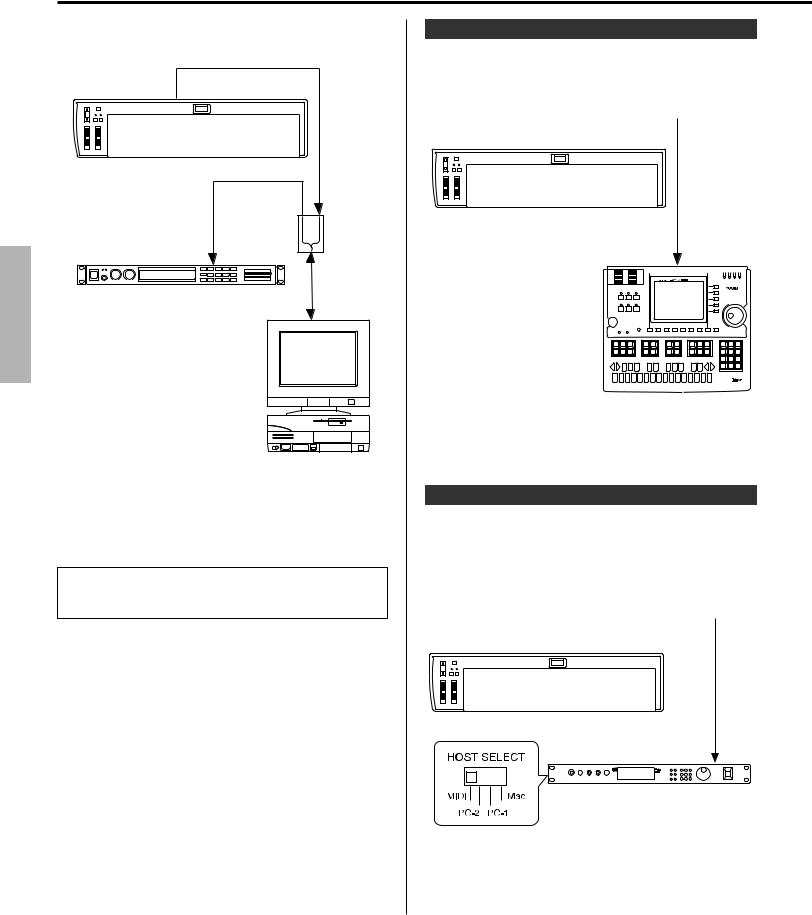
Setting Up Your CBX-K2
For tone generators without a built-in MIDI interface
|
CBX-K2 |
|
|
|
|
MIDI OUT |
||||||||||||||||||||||
|
|
|
|
|
|
|
|
|
|
|
|
|
|
|
|
|
|
|
|
|
|
|
|
|
|
|
|
|
|
|
|
|
|
|
|
|
|
|
|
|
|
|
|
|
|
|
|
|
|
|
|
|
|
|
|
|
|
|
|
|
|
|
|
|
|
|
|
|
|
|
|
|
|
|
|
|
|
|
|
|
|
|
|
|
|
|
MIDI OUT |
MIDI IN |
MIDI
Interface
MIDI IN
Tone generator
Serial port
Computer
Connect the MIDI OUT terminal on the CBX-K2 to the MIDI IN terminal on the computer’s MIDI interface. The tone generator should be connected to a MIDI OUT on the interface.
NOTE ■ Set the MIDI Thru (or Echo Back) setting on the sequencer software to ON.
As for the required MIDI settings for the computer and sequencer software, refer to the respective manuals.
With Sequencer
The CBX-K2 can be used with a stand-alone sequencer, for recording and editing performance data.
|
CBX-K2 |
|
|
|
MIDI OUT |
|
|||||||||||||||||||||||
|
|
|
|
|
|
|
|
|
|
|
|
|
|
|
|
|
|
|
|
|
|
|
|
|
|
|
|
|
|
|
|
|
|
|
|
|
|
|
|
|
|
|
|
|
|
|
|
|
|
|
|
|
|
|
|
|
|
|
|
|
|
|
|
|
|
|
|
|
|
|
|
|
|
|
|
|
|
|
|
|
|
|
|
|
|
|
|
|
|
|
|
|
|
|
|
|
|
|
|
|
|
|
|
|
|
|
|
|
|
|
|
|
|
|
|
|
|
|
|
MIDI IN
Sequencer
Connect the MIDI OUT terminal on the CBX-K2 to the MIDI
IN terminal on the sequencer.
With Tone Generator
In the simple system below, the CBX-K2 is used to play the voices of the MU100R Tone Generator. This setup could also serve as a simple, yet powerful live performance rig, with the CBX-K2 being used as a portable keyboard controller.
CBX-K2 |
MIDI OUT |
|||||||||||||||||||||||||||
|
|
|
|
|
|
|
|
|
|
|
|
|
|
|
|
|
|
|
|
|
|
|
|
|
|
|
|
|
|
|
|
|
|
|
|
|
|
|
|
|
|
|
|
|
|
|
|
|
|
|
|
|
|
|
|
|
|
|
|
|
|
|
|
|
|
|
|
|
|
|
|
|
|
|
|
|
|
|
|
|
|
|
|
|
|
|
MIDI IN
Tone generator
MU100R
Connect the MIDI OUT terminal on the CBX-K2 to the MIDI
IN terminal on the MU100R.
14
